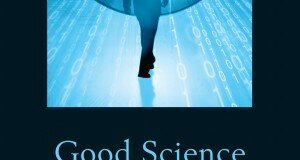Wouldn’t it be great to be able to communicate with the computer
like Captain Picard or Captain Kirk does on “Star Trek”?*
David Ferruci, Principal Developer for IBM’s Watson
Jean Baudrillard (1989) claimed that Americans were simulations. In other words, Baudrillard argued that, not only did Americans have a flair for creating elaborate fantasies, but Americans were also consumed by those fantasies (Baudrillard, 1994).Indeed, it was this particular insight that inspired the Wachowski Siblings to compose their epic Matrix trilogy (Merrin, 2005). Admittedly, Baudrillard’s observations often border on the absurd; however, he does make the valid observation that Americans are becoming increasingly wedded to media technologies—so much so that many find it distressing to unplug even briefly from their digitally-mediated realities (Dretzin, 2010).
For Baudrillard, the American obsession with simulations was an indicator of the futility of the postmodern era: he believed that when people began caring more about illusions than reality, the significance of human endeavors would dwindle to vaporous futility. While I concur with a number of Baudrillard’s observations, I differ regarding the utility of simulations. More than once, artfully constructed fantasies have literally altered the course of human events. For instance, in the nineteenth century, Jules Verne concocted outlandish visions of the future that thrilled his many readers. While it would be an overstatement to suggest that Verne’s science fiction fantasies laid the groundwork for the historical events that were to follow, still, it is fair to say that a number of Verne’s diehard fans made a concerted effort to transform his fantasies into reality. For example, in Verne’s day, a fully electronic submarine was a work of pure imagination. However, in the century that followed, engineering marvels that bore a striking resemblance to Captain Nemo’s fictional submarine began plumbing the depths of the seven seas. Indeed, it is noteworthy that the first nuclear submarine in the US fleet was named the Nautilus.
Thus, in certain respects, one can argue that the future is shaped by fantasies.
More recently, the adventures of Captain Kirk and the Starship Enterprise have served as an inspiration for an entirely new breed of future-seekers. Though some might think that a (brilliantly!) cheezy TV series from the 1960s would have little impact on the work of real scientists, in fact, Star Trek has captured the imaginations and influenced the work of more than a few important innovators (Jones, 2005). For example, Martin Cooper has stated that he was motivated to invent the cell phone after watching Captain Kirk use a wireless communicator on Star Trek.
Of course, everyone knows that Captain Kirk did no such thing. For the literalists among us, it is essential to point out that Captain Kirk is a fictional character and none of the technology that he used was real. In short, Star Trek is a work of pure imagination and, therefore, it is demonstrably disconnected from real events in the real world.
…or is it?
Ever since Star Trek hit the airwaves, enthusiasts have been determined to erase the boundary between the realm of Star Trek fantasy and the real world. Although many Trekkies have become submerged in what Baudrillard would characterize as a pointless simulation (Nygard, 1997), others have derived sufficient motivation from Star Trek to successfully redefine reality (Jones, 2005).
Can fantasies transform reality?
It is worth noting that, just as the first nuclear submarine was named the Nautilus, the first space shuttle orbiter was named the Enterprise. Further, David Ferruci, the principal developer for IBM’s Watson (www.watson.ibm.com/index.shtml **), has stated that, in part, his motivation for building Watson was to create an artificially intelligent computer with which people might one day converse as Captain Kirk does with his computer on the Starship Enterprise. Though the source of Ferruci’s motivation has the charm of a childhood fantasy, it is also much more than that. Rather than getting lost in the fog of a captivating dream, Ferruci translated his enthusiasm for Star Trek into a wildly successful initiative to construct the “smartest machine on earth” (Bicks, 2011). In doing so, Ferruci literally shifted the boundary between fantasy and reality: where, once upon a time, computers that were capable of outplaying human trivia experts were the stuff of fantasy, thanks to Ferruci’s Star Trek-inspired dream, they are now a reality.
As a result, though Baudrillard would surely disagree, I argue that fantasies often serve as a wellspring of creativity from which human agents derive the requisite motivation to redefine reality (McGettigan, 2011). Indeed, while David Ferruci and his colleagues endeavor to build the next generation of talking computers, other folks are pursing even more (dare I say it?) enterprising goals.
In collaboration with NASA, DARPA has recently announced the 100 Year Starship Study (http://100yearstarshipstudy.com/). The stunningly ambitious aim of this study is to design a spacecraft with galaxy-exploring capabilities that are eerily similar to those possessed by the Starship Enterprise. Is this merely a coincidence? I doubt it. For humans, the future is a process. If we want to live in a better, brighter future, then we need to dream big dreams today—and then do our utmost to transform those dreams into reality. Though pessimists like Baudrillard would surely sneer, it is evident that science fiction-inspired dreams have a demonstrated capacity to shift the boundary between fantasy and reality. Thus, for anyone who desires to go where no one has gone before, we can continue relying on Captain Kirk to get us there.
Warp factor nine, Mr. Sulu!
References
Baudrillard, Jean, 1989. America. New York: Verso.
Baudrillard, Jean, 1994. Simulacra and Simulation. Translated by Sheila Farrier Glaser. Michigan: The University of Michigan Press.
Bicks, Michael, 2011. “Smartest Machine on Earth.” Nova. PBS International.
Dretzin, Rachel (Director and Producer), 2010. “Digital Nation: Life on the Virtual Frontier.”Frontline. Boston, MA: Public Broadcasting Service, WGBH.
Jones, Julian, 2005. How William Shatner Changed the World. Vancouver, Canada: The Discovery Channel.
McGettigan, Timothy, 2011. Good Science: The Pursuit of Truth and the Evolution of Reality. Lanham, MD: Lexington Books.
Merrin, William, 2005. Baudrillard and the Media: A Critical Introduction. Waltham, MA: Polity Press.
Nygard, Roger, 1997. Trekkies. Los Angeles, CA: Neo Motion Pictures.
* A complete transcript of this interview is available at the following website:
http://www.pbs.org/wgbh/nova/tech/will-watson-win-jeopardy.html
**Is it just me, or is the IBM researcher depicted in the photo atop this page attempting to mind meld with Watson?
Cite This Article
Timothy McGettigan (2012). Living the Dream: Transcending the Boundary between Sci-Fi and Reality. The Socjourn. [https://sociology.org/beam-scotty-science-fiction-wellspring-scientific-progress/]

The Great Awakening: Concepts and Techniques for Successful Spiritual Practice
By: Dr. S.The Great Awakening: Concepts and Techniques for Successful Spiritual Practice (GA) is your key to initiation of spiritual Awakening. The book is a primer of right thinking and basic spiritual technique designed to point you in the right direction, give you the tools you need to get started, and set you on the fast path back home. The Great Awakening consists of a collection of short essays on basic spiritual topics like breathing, grounding, visualization, communicating with spirit, spiritual protection, and so on. The Great Awakening is not a long book nor a complicated book, but it is an important book. If you are going to navigate the early stages of your (voluntary or involuntary) spiritual awakening process as safely and effectively as possible, you need to know basic concepts and techniques in this book. Knowing the concepts in this book can make the difference between anxiety, confusion, pain, suffering, and even untimely death, and calm, measured advance forward towards glorious, divine, consciousness.
[ Kindle | Amazon.com | Book Finder | Download PDF | Download Kindle ]
Full Entry
 The Socjourn A New Media Journal of Sociology and Society
The Socjourn A New Media Journal of Sociology and Society


